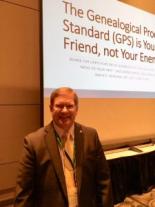Skillbuilding, NGS 2018: David Rencher, AG, CG®
-
Created on 14 May 2018
SpringBoard is pleased to offer a review of this BCG Skillbuilding lecture, presented 2 May 2018.
W121, David Rencher, AG, CG®, FIGRS, FUGA, “The Genealogical Proof Standard (GPS) is Your Friend, not Your Enemy”
Reviewed by Jill Morelli, CG®
“We are going to have some fun today!” was how David Rencher, AG, CG®, FIGRS, FUGA, began the first presentation on the first day of the National Genealogical Society 2018 conference held in Grand Rapids, Michigan.
The Genealogical Proof Standard (GPS) does not usually elicit that kind of excitement, but in this case it was deserved.[1] David made the GPS “approachable” and provided us with a GPS toolbox that everyone, whatever their skill level, can use successfully. He accomplished this by clarifying each element in “friendlier” words. He pointed out some common examples of how we might become stymied as we work to solve problems, but he also showed us how the GPS can help us avoid traps as we strive to do our best work and break through brick walls.
David reviewed the five principles of the GPS, pointing out that this is not a checklist but rather the foundation to our everyday work. The thought processes that might trip us up were identified and illustrated how the GPS can help.
- Element 1: “Gathering the evidence--when is enough enough.”[2]
We often do not search broadly enough, or we too readily accept the work of others, even when undocumented. As researchers we should identify multiple records, which provide evidence that support our research question. Having multiple sources allows us to assess the relative quality of each source and gain confidence in our conclusions.
- Element 2: “Identifying the breadcrumbs back to the source”
Without source citations, we are left without “breadcrumbs” to lead us back to the source and also lose our ability to analyze that source. David paused here in the presentation and expressed his wish for a computer app that would take all the Internet sites he looked at during a day and generate the citations (in the format of Evidence Explained, of course) at the end of a research day![3] If the nodding heads were any indication, this would be welcomed by the audience members as well.
- Element 3: “Correlating your findings and analyzing your facts”
When we find one methodology that solves a problem, we might inappropriately apply that same methodology to future problems. When the application of one methodology doesn’t work, we might too quickly label the problem as a “brick wall.” Recognizing that different problems often require different approaches is critical to genealogical success. Correlation and analysis, effectively applied, can resolve many of those problems.
- Element 4: “Checking for discrepancies--resolving the conflicting evidence”
We must guard against the dismissal of facts that are not in alignment with our understanding of our family. David presented the following examples of situations we might encounter and make efforts to dismiss: “our” ancestors didn’t own slaves, or we always spelled “Brown” with an “e.” We should recognize that family myths may be true, false or partially true—even if uncomfortable.
- Element 5: “Crossing the finish line--Writing the Conclusion!”
An often heard statement is “I like doing the research, but I don’t like writing the report.” David urged us to record our family discoveries. Writing their stories results in an encapsulation of an ancestor’s life, which solves a mystery of the past. We need to embrace the joy of writing our ancestors’ stories.
Once known and accepted these principles can be built upon, increasing our skill level in all our work. No matter the skill level, they are fundamental to everyone’s research. Ultimately, the genealogist will arrive at the point where a research question cannot be answered due to a lack of records to prove an identity or relationship. If you have followed the GPS, then you know you have done enough.
David used an expression from his childhood that I had not heard before: “kick the cactus.” When he was exasperated with a situation, his mother told him to take care that he did not “kick the cactus.” We may find ourselves in that same situation with our inability to break through that brick wall. If we “kick the cactus,” the kick will hurt us more than it will hurt the cactus. If the Genealogical Proof Standard is not applied we have “kicked the cactus,” hurting ourselves and our descendants, who are now forced to re-do our life-long work. If, instead, we carefully apply the Genealogical Proof Standard to our everyday work, we will find that it gives us greater confidence in our results and something we are proud to pass to those who will continue our work.
A recording of this lecture may be ordered from Playback Now www.playbackngs.com.
[1] For the Genealogical Proof Standard see: Board for Certification of Genealogists. Genealogy Standards 50th Anniversary Edition. (Washington, D.C.: Ancestry, 2014) 1-2.
[2] David Rencher, “The Genealogical Proof Standard is Your Friend, Not Your Enemy,” lecture W121 and syllabus p. 5, National Genealogical Society Annual Conference : Grand Rapids, Michigan, 2018. Heading titles used with permission of the author.
[3] Elizabeth Shown Mills, Evidence Explained: Citing History Sources from Artifacts to Cyberspace, 3rd edition revised (Baltimore: Genealogical Publishing Company, 2017.)
The words Certified Genealogist and letters CG are registered certification marks, and the designations CGL and Certified Genealogical Lecturer are service marks of the Board for Certification of Genealogists®, used under license by board certificants after periodic evaluation.
